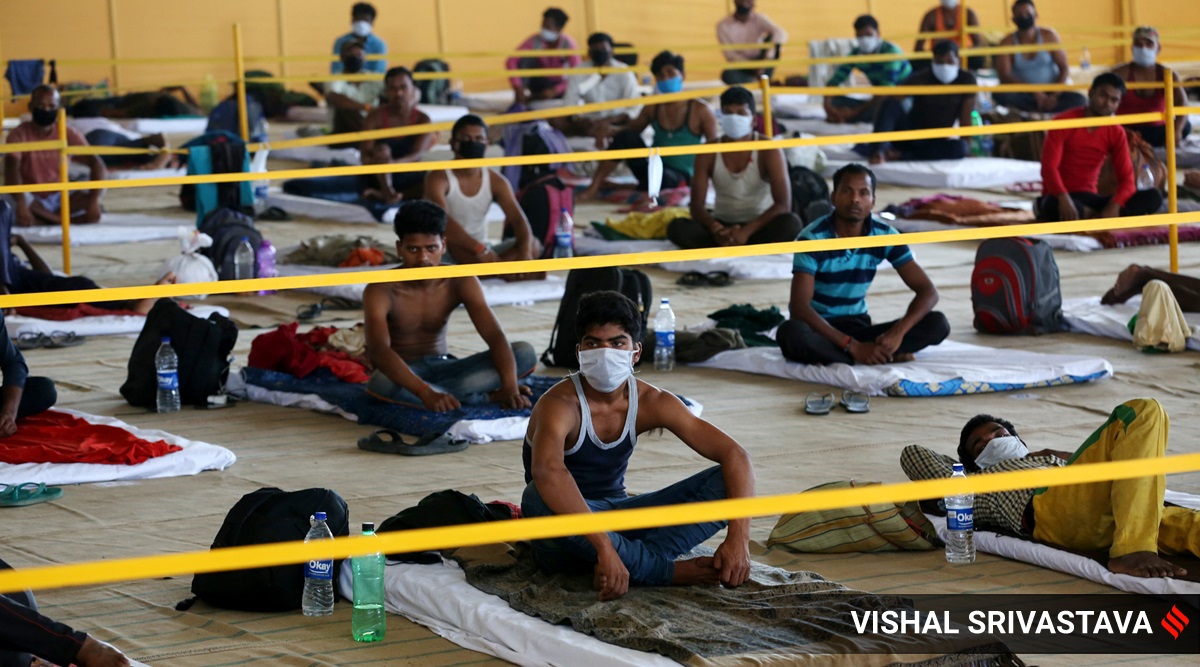 Migrant workers returning from other states at a shelter home in Lucknow in April. The government had set up shelter homes across the state where returning migrant workers were made to stay for two weeks before being allowed to go to their villages. (Express Photo: Vishal Srivastav)
Migrant workers returning from other states at a shelter home in Lucknow in April. The government had set up shelter homes across the state where returning migrant workers were made to stay for two weeks before being allowed to go to their villages. (Express Photo: Vishal Srivastav) Among the first handful cases of novel coronavirus that were reported in the country in March this year, a few were from Agra in Uttar Pradesh. With Uttar Pradesh being the most populous state in the country, there were increasing apprehensions about how the Covid-19 outbreak would pan out in a state lacking health infrastructure and generally poor public hygiene.
Nine months later, Uttar Pradesh has reported over 5.83 lakh Covid cases and nearly 8,400 deaths. With a case-fatality rate 1.5 per cent – has been almost the same since the beginning of the outbreak — and a recovery rate touching 96 per cent, Uttar Pradesh is ranked seventh among Covid-hit states, below Maharashtra, Karnataka, Andhra Pradesh, Tamil Nadu, Kerala and Delhi that have far smaller populations vis-a-vis Uttar Pradesh.
With new Covid cases declining steadily in the last month, there is some relief as well as caution amid the advent of the new UK strain of the virus, which is considered highly contagious.
Vaccination drive
While 2020 was mainly about stopping the spread of infection, the challenge for the health officials in the coming year will be to vaccinate the population once the Covid-19 vaccinations are approved by the Centre. The government has claimed to have tripled the capacity of vaccine storage — from 80,000 litres to 2.5 lakh litres. Also, plans are afoot to set up 35,000 centres to conduct the vaccination drive. However, given the population of the state — more than 23 crore — the same is not without challenges.
Challenges & Lessons
In March, when the outbreak began, like every other state Uttar Pradesh too was ill-prepared for a pandemic like Covid-19. The facility to detect the cases through RT-PCR test was then available only at Lucknow’s KGMU. The cost of carrying out an RT-PCR test was high – close to Rs 4,000 – with supply of reagents used in the test scarce. However, the government stepped in and set up new labs across the state. Now, the state has at least 45 government laboratories equipped for RT-PCR testing. Besides, other testing methods – TrueNat and Antigen — approved by the ICMR have also been incorporated. Now, Uttar Pradesh carries out roughly over 1.60 lakh tests for coronavirus in one day – the highest in the country – with 40 per cent of them being RT-PCR. So far, the state has carried out over 2.36 crore tests for coronavirus, the highest in the country.
A positive side-effect of the pandemic has been the government’s impetus to setting up new health infrastructure. Since infected people were to be kept in isolation, the government in the initial days of the pandemic, divided Covid-designated facilities into three: L-1 hospitals, those with basic bare minimum facilities to house asymptomatic and mildly symptomatic patients; L-2 hospitals with oxygen supply facility; and lastly L-3 hospitals, those equipped with ICUs and ventilators.
The state, which had six L-3 hospitals to begin with in April, now has at least 25 hospitals of that category, besides 229 L-1 and 71 L-2 hospitals.
As waves of infection kept the state on the edge, the pandemic situation did not spin out of control. One reason could be attributed to contact tracing, say health officials. “What turned out to be good for us was the daily core committee meeting either on the Chief Minister’s level or on the level of the state Health Department. We were analysing and monitoring the situation on a daily basis and every day important decisions were being taken. The gamechanger was the surveillance teams formed for the extensive contact tracing. So, when migrants started returned to the state in thousands, we were prepared for it,” said Vikasendu Agarwal, who is in charge of the state’s Covid surveillance efforts.
The experience gained from the door-to-door campaign DASTAK that was launched in 2018 against Acute Encephalitis Syndrome and Japanese Encephalitis, and the experience of ASHA workers in immunization drives, came in handy as they were incorporated for the Covid surveillance campaign.
According to officials, the health facilities in the state are much better than what they were at the end of 2019 because of the pandemic. Several basic equipment that were not available have now been installed in the government hospitals, doctors and paramedical staff have been trained in using them, and all these are expected to pay in long term.